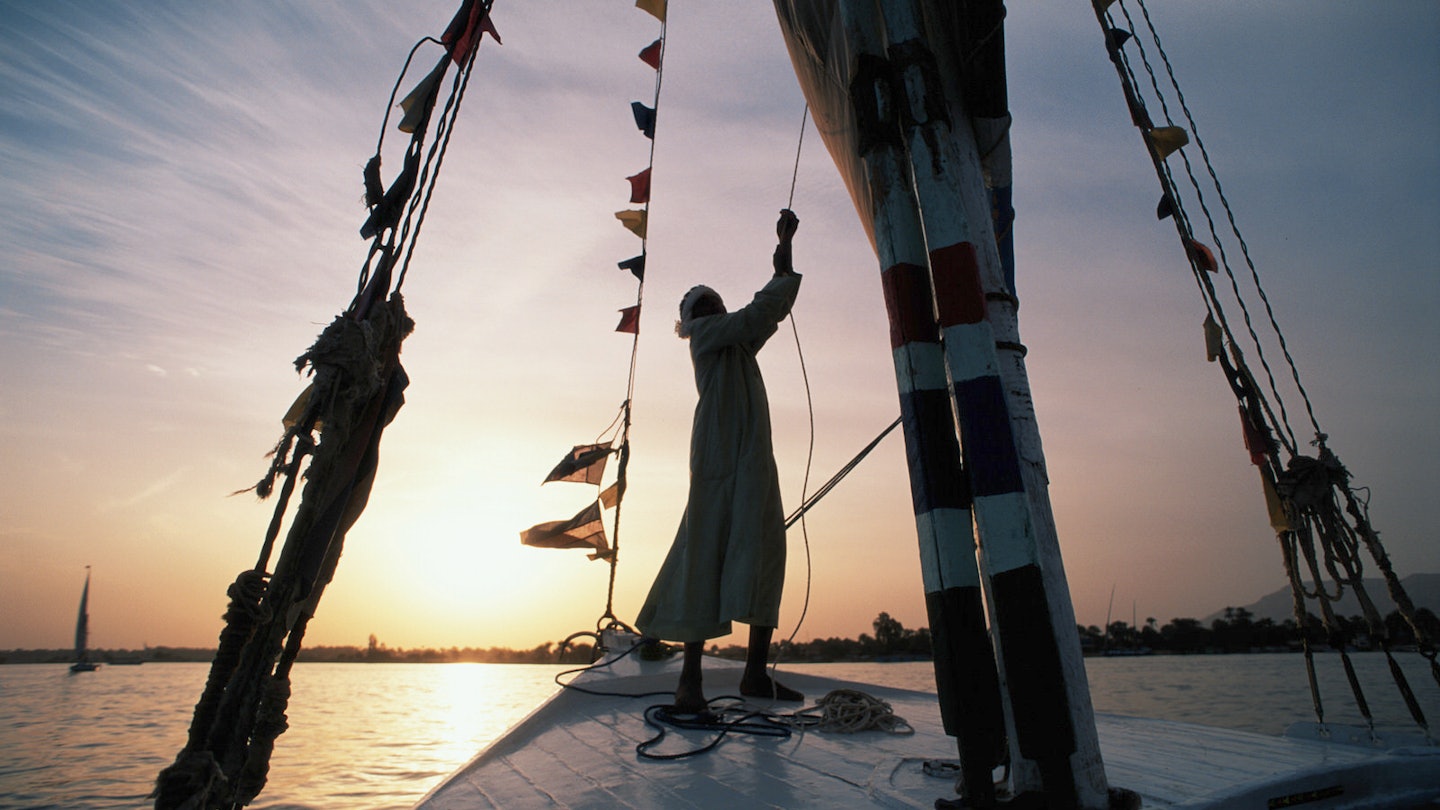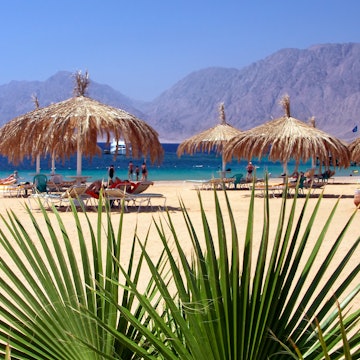

Egypt, Aswan, man sailing felucca on River Nile, sunset
Compared to Egypt’s other cities, life unfurls at a slower pace in Aswan. The country’s most southern city offers a chance to catch your breath after the nerve-fraying, car-horn-tooting bedlam of Cairo. Often mistaken as a stop-gap destination – a place to breeze through between an Abu Simbel day trip and embarking on a journey down the Nile – low-key Aswan is instead a place to sit back and savour.

‘Welcome to Alaska!’ will probably be the first greeting you hear in Aswan. This local joke about the debilitating heat will follow you everywhere during your stay. Maybe the temperature helps along Aswan’s laidback attitude; after all, it’s hard to hustle when the thermometer’s tipping over 40˚C. Whatever it is, Aswan is a languid place and a noticeable contrast to Luxor and Cairo further north. But that doesn’t mean there’s little to do. Packed full of history and offering a distinct Nubian culture, there’s plenty to waylay you here before you board your felucca (a small traditional sailboat) or cruise boat to Luxor.

Village life in the city
One of Aswan’s great joys is its juxtaposition of rural and urban. While the city hub rims the east bank, all you have to do is hop on a local ferry to Elephantine Island or Gharb Aswan on the west bank, and within a few minutes you’re surrounded by traditional Nubian village life. Elephantine Island’s two neighbouring villages of Siou and Koti are a miniature maze of wriggling lanes lined with squat mudbrick houses, where walls are splashed with colourful murals, leading to a patchwork of gardens overlooked by swaying date palms.
At the island’s southern tip are the Ruins of Abu, ancient Aswan’s centre. Walk down the narrow stairs, cut into blackish boulders, to where the river laps against the shore to see the age-old nilometers that once recorded the river’s level – and hence the condition of the harvest. Wander through the jumble of small temples and buildings that showcase Aswan’s importance as a major stop on the caravan routes between ancient Egypt and Nubia. While on Elephantine Island search out Animalia, a little museum brimming with Nubian artefacts and home to a lovely terrace that makes for a great place for a tea pit stop after exploring.

Taking to the river
If you’re only going to board a felucca on the Nile once while you’re in Egypt, it better be in Aswan. A half day tacking around the palm-studded islands with the lateen sails unfurled above you is one of Egypt’s iconic experiences and is by far the most relaxing way of soaking up the scenery. For the best views, head south on a longer trip to Seheyl Island, which sits just north of the old Aswan Dam. But even a short trip on the River Nile offers close-up vistas of riverine life, spotting ibis perched on boulders while skimming near tiny rocky islets with the high golden sand dunes of the west bank rising up beyond.
Add in a couple of stops at some of Aswan’s most famous historical sites, and you can combine a bit of sightseeing with your sailing. One of the most popular stops on a felucca jaunt is the Tombs of the Nobles, where ancient Abu buried their governors and other important bigwigs within the west bank’s hollowed-out cliffs. From here, you can sail along the west bank to see the 7th-century Monastery of St Simeon, surrounded by sturdy fortress walls. Disembark at the river bank and saddle up on a camel to see the monastery up close. Another popular stop on a felucca trip is Kitchener’s Island, home to Aswan Botanical Garden, first planted by Lord Horatio Kitchener in the late 19th century.

On the east bank
Although the river will always be Aswan’s biggest draw, the east bank also has a clutch of sights. Do not miss a visit to the Nubia Museum if you want to dig a bit further into Nubian culture. This small museum displays the unique culture and traditions of Nubia as well as documenting the huge amount of Nubian history that was lost with the building of the Aswan High Dam.
To admire the sheer ambition of ancient Egypt’s builders, pay a visit to the Unfinished Obelisk. The obelisk would have measured more than 40m high and weighed an estimated 1200 tonnes if completed, but the stonecutters discovered cracks in the granite and had to abandon the project, so it still sits in situ, half chiselled out of the bedrock.
One of Aswan’s great joys is simply strolling the east bank’s Corniche, watching the feluccas duck and weave between the islands. Make sure to factor in time for some aimless promenading along this Nile-side street to see the sun set over the river. Aswan’s real charm has always been its ambience rather than its sights.

Top tips for visiting Aswan
It’s hot. During summer temperatures regularly zoom into the mid-40s. Avoid June to September if at all possible.
If you enjoy slow travel, take the train to Aswan. The 8am departure from Cairo is the best option for scenery.
The most popular day trips from Aswan are to the Temples of Abu Simbel and to the Temple of Isis (often called Philae Temple). All the hotels in Aswan can organise tours.















